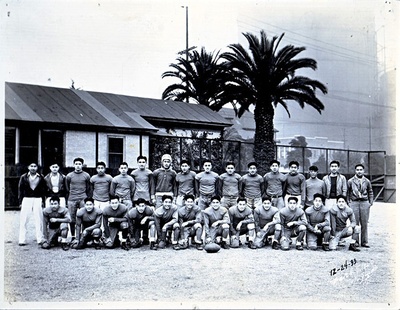At first, the Olivers seemed like an elusive group. For years, as I was doing research in Little Tokyo for my dissertation, I would hear people mention the Olivers and I was always curious. Who were they? What was their role in Little Tokyo’s history? And what was up with that name? Eventually I learned that the name was associated with Nisei sports activities, but wanted to find out more. Finally, I had a chance to work with the Little Tokyo Service Center on a grant application that allowed me to find out the answers to these questions through a deeply rewarding investigation into Japanese American history in Los Angeles. Given the thirty-plus years that Little Tokyo has been waiting for a recreation center that will put sports back at the center of the community, it seemed particularly relevant now to discover the ongoing legacy of Little Tokyo’s prewar sports history.
A California Stories grant from the California Council for the Humanities funded our video oral history project on the Olivers, a group of social and sports clubs in Little Tokyo that were started in 1917 by a dedicated teacher, Miss Nellie Grace Oliver. Miss Oliver taught young Nisei how to speak in public, follow parliamentary procedure in meetings, and sing in harmony – the cultural capital they would need to challenge anti-Japanese prejudice in their adult lives. The Oliver teams provided a recreational outlet to inner-city youth, excelling in baseball, football, and basketball at both the local and state level until the spring 1942 internment order and the 1947 death of Miss Oliver brought an end to the clubs. As the Olivers grew into adulthood and established families of their own, their thoughts turned to their former teacher and mentor. So in 1961, former Olivers got together to re-establish the club, bestowing an annual award on the outstanding Japanese American high school athlete in Southern California in Miss Oliver’s name. They continued this custom for an astounding forty years, fostering a tradition of Japanese American athletic achievement that continues today.
It was a great privilege for videographer Steve Wong and myself to be invited into the homes of exceptional Nisei athletes, who generously shared their childhood memories with us. In addition to hearing about Miss Oliver and the tradition of sporting excellence in the Japanese American community, we learned about overworked Issei parents, sibling rivalries, employment discrimination, military training, resettlement stress, children’s accomplishments, and the long-term importance of family, friends, and community. One of my favorite moments was Ets Yoshiyama recalling that his father paid him two dollars to clean up the family’s business establishment. Ets, ever the entrepreneur, hired his younger brother to do it for him for 50 cents, thus making a very tidy profit! Another amusing anecdote came from Harry Yamamoto, who explained how Mickey Rooney’s Football All-Stars, humiliated after repeated beatings at the hands of the Olivers, brought in the Santa Monica High School varsity team as ringers to exact their revenge. “They beat us then,” said Harry. “Not bad, but they beat us.” Taking someone’s oral history is such an enriching exercise in imagination and empathy. Not surprisingly, I found these interviews were definitely my favorite part of the process. I made wonderful, wise new friends.

Olivers and family members examine the Olivers exhibit in Little Tokyo on opening day, May 19, 2007, Little Tokyo, Los Angeles, Calif.
After we had completed the oral histories, the next step in our project was scanning the photographs and documents that our Oliver subjects had managed to retain over the years. Given the difficulties inherent in retaining photo albums through the chaos of evacuation, internment and resettlement, I was grateful to discover that many Olivers photos from the 1920s and 1930s still survived. Another excellent resource I mined was a short history of Miss Oliver and the clubs that had been written by honorary Oliver Frank Fukuzawa while the Club was still active. I combined representative photos and interview quotes to create a brief visual narrative of the Olivers’ history, which is now on display in the lobby of the DISKovery Center inside the Far East Building on East First Street in Little Tokyo.
The final step in our project, posting the photos, documents, and short video clips from our oral history interviews to an online Olivers exhibit at Nikkei Album (www.discovernikkei.org/nikkeialbum/en/node/2237), was especially satisfying. I was able to share the Olivers’ stories with a global audience, who can comment on the items and expand the story by linking up with collections of their own. The next person working in Little Tokyo who hears mention of the Oliver name can find out all about them with a few clicks of a mouse, making the Olivers elusive no more!
© 2007 Hillary Jenks




